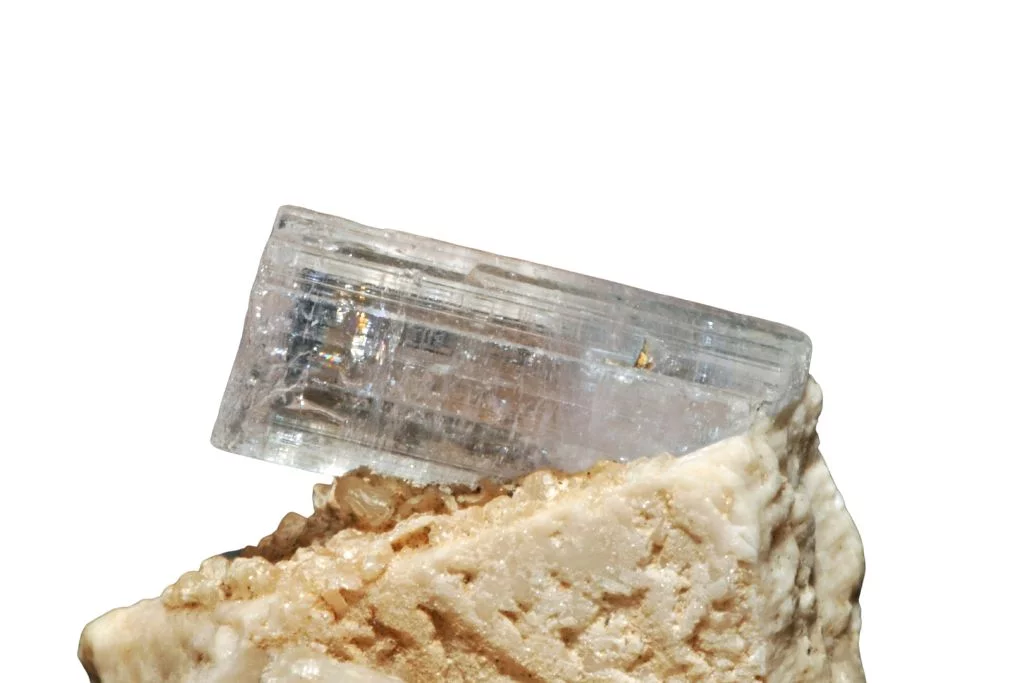Color and Transparency
Achroite, a unique variety of tourmaline, is characterized by its exceptional clarity and colorless appearance. True to its name, which derives from the Greek word “achroos” meaning “colorless,” this crystal exhibits a remarkable transparency that sets it apart from other tourmaline varieties. The absence of color allows light to pass through the crystal unimpeded, creating a glass-like appearance that can be mistaken for quartz or topaz at first glance.
Crystal Structure
Achroite crystals typically form in a prismatic habit, displaying elongated, columnar shapes with distinct vertical striations along the crystal faces. These striations are a hallmark feature of tourmaline minerals and contribute to the crystal’s unique aesthetic appeal. The crystal system of Achroite is trigonal, which means it has three-fold rotational symmetry around its primary axis.
Physical Properties
Achroite exhibits a vitreous to resinous luster, enhancing its resemblance to glass or clear resin. It has a hardness of 7 to 7.5 on the Mohs scale, making it suitable for use in jewelry. The crystal’s density ranges from 3.02 to 3.26 g/cm³, slightly higher than that of quartz. One of the most intriguing physical properties of Achroite is its pyroelectric and piezoelectric nature, allowing it to generate an electrical charge when heated or subjected to pressure.
Notable Features
What truly makes Achroite stand out is its ability to display chatoyancy, also known as the “cat’s eye” effect, when cut en cabochon. This optical phenomenon, caused by parallel inclusions within the crystal, creates a bright line of light that appears to glide across the surface as the stone is moved. Additionally, some Achroite specimens may exhibit a faint blue or green tint due to trace elements, adding subtle color variations that gemologists and collectors find particularly appealing.
What is Achroite
Achroite, also known as colorless tourmaline, is a rare and highly prized gemstone variety. This transparent to translucent crystal belongs to the tourmaline family and is characterized by its lack of color, which sets it apart from its more vividly hued counterparts. The name “achroite” is derived from the Greek word “achroos,” meaning colorless.
Metaphysical Properties
In the realm of crystal healing and metaphysics, achroite is believed to possess powerful energetic properties. It is often associated with clarity of mind, purity of spirit, and enhanced intuition. Many practitioners use achroite as a tool for spiritual growth and self-discovery, claiming that it helps to clear negative energies and promote a sense of inner peace.
Traditional and Modern Applications
Historically, achroite has been used in jewelry making, particularly in high-end and bespoke pieces. Its rarity and unique appearance make it a sought-after gemstone for collectors and connoisseurs. In modern times, achroite has gained popularity in alternative healing practices. It is often used in meditation, placed on chakras, or worn as jewelry to harness its purported benefits.
Believed Benefits
Proponents of crystal healing assert that achroite can provide various benefits to its users. These include enhancing mental clarity, promoting emotional balance, and facilitating spiritual growth. Some believe that achroite can help in overcoming obstacles, releasing old patterns, and opening oneself to new possibilities. Additionally, it is thought to stimulate creativity and aid in decision-making processes.

